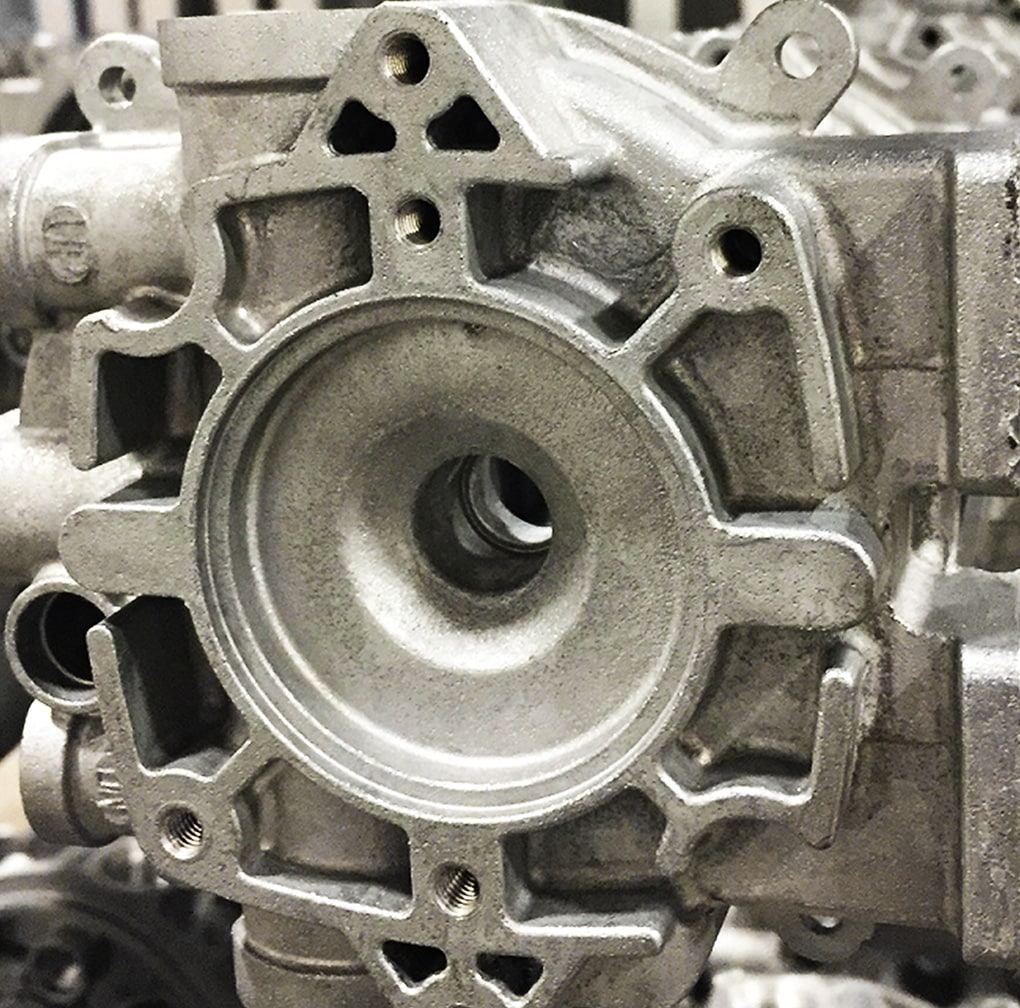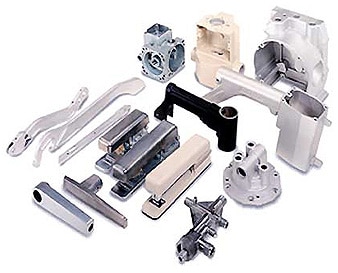Revealing the Conveniences and Practical Utilizes of Aluminum Castings in Today's Market
Light weight aluminum castings have come to be increasingly relevant in numerous markets as a result of their distinct characteristics. Their light-weight nature and resistance to rust make them suitable for demanding applications. In addition, the exceptional strength-to-weight ratio supplies considerable benefits in design and manufacturing. As sectors proceed to explore their capacity, the complete scope of light weight aluminum spreadings' benefits and applications stays to be totally revealed. What exists in advance for this functional material?
The Lightweight Advantage of Light Weight Aluminum Castings
Although several products are made use of in manufacturing, aluminum castings stand apart mainly due to their lightweight residential properties. This particular makes aluminum castings an attractive selection for various sectors, specifically in aerospace and automobile applications, where weight decrease is important for enhancing gas efficiency and performance. The light-weight nature of light weight aluminum enables producers to produce parts that are easier to take care of and install, eventually reducing labor expenses.
The capacity to produce intricate shapes without considerable weight penalties allows designers to introduce while preserving structural honesty. Aluminum spreadings can efficiently change larger products, leading to significant savings in shipping and operational expenses. Their lightweight benefit likewise adds to improved product longevity, as lighter elements commonly cause lowered wear and tear on machinery. Generally, the light-weight properties of aluminum castings offer manufacturers with an one-upmanship, cultivating developments in item style and performance across numerous fields.

Outstanding Rust Resistance
Light weight aluminum spreadings possess a natural resistance to oxidation, which considerably boosts their longevity in numerous atmospheres. This intrinsic property not just adds to their longevity however likewise aligns with the lightweight advantage that aluminum uses. Therefore, aluminum castings are increasingly acknowledged for their outstanding rust resistance in countless applications.

Naturally Immune to Oxidation
One of the standout attributes of aluminum spreadings is their phenomenal corrosion resistance, which comes from a natural oxidation process. When subjected to air, light weight aluminum reacts to develop a thin, safety layer of light weight aluminum oxide. This layer functions as an obstacle against additional oxidation and safeguards the underlying steel from harsh components such as moisture and salts. Unlike various other steels, this oxide layer is self-repairing; if harmed, it swiftly reforms when exposed to air. This one-of-a-kind home improves the long life of aluminum spreadings in different atmospheres, making them ideal for applications in markets such as aerospace, automobile, and marine. The all-natural resistance to oxidation considerably minimizes upkeep prices and enhances the reliability of aluminum spreadings in requiring conditions.
Lightweight Durability Advantage
The lightweight nature of light weight aluminum spreadings adds considerably to their durability, making them an advantageous selection in numerous industries. This extraordinary toughness is greatly credited to light weight aluminum's inherent resistance to corrosion, which is improved additionally through anodizing and various other surface area treatments. Unlike numerous metals, aluminum does not rust; instead, it forms a safety oxide layer that guards it from ecological damages. This property is particularly advantageous in sectors such as vehicle and aerospace, where weight reduction is vital without jeopardizing stamina. In addition, the longevity of aluminum spreadings decreases upkeep expenses and substitutes, giving economic advantages in time. As a result, their lightweight longevity and rust resistance placement aluminum spreadings as a premium material for modern-day manufacturing applications.
Superior Strength-to-Weight Ratio
An impressive attribute of light weight aluminum spreadings is their exceptional strength-to-weight ratio, which makes them highly preferable in different applications. This innate property allows light weight aluminum castings to endure significant tension while remaining light-weight, an essential factor in markets such as aerospace, automotive, and production. Engineers typically favor aluminum spreadings for elements that require both toughness and minimized weight, boosting fuel effectiveness and performance.
The high strength-to-weight proportion also helps with the design of detailed shapes and frameworks, making light weight aluminum castings flexible for complicated applications. Additionally, the capability to keep architectural integrity under tough conditions assurances longevity and dependability in products, from aircraft frameworks to automobile components. This advantage adds to the expanding fad of utilizing aluminum spreadings in cutting-edge layouts, eventually leading to enhanced functionality and effectiveness across varied sectors. The remarkable strength-to-weight proportion of light weight aluminum spreadings places them as a pivotal material in modern-day design and production.
Cost-Effectiveness in Production
Cost-effectiveness in aluminum casting manufacturing is primarily achieved with lowered material waste and effective production procedures. By enhancing designs and using innovative strategies, producers can lessen excess product use while maintaining high quality requirements. This strategy not only lowers manufacturing expenses yet also adds to extra lasting practices within the industry.
Minimized Material Waste
Lowering product waste in light weight aluminum spreading procedures significantly enhances manufacturing performance. By maximizing the layout and production strategies, firms can lessen excess scrap and enhance resource usage. This reduction in waste not just reduces material costs but also contributes to a more lasting manufacturing model. The ability to reuse light weight aluminum more assistances cost-effectiveness, enabling manufacturers to recover and recycle materials without jeopardizing top quality. As the industry significantly concentrates on sustainability, minimized material waste straightens with environmental goals while concurrently increasing success. Inevitably, efficient use of basic materials enhances the competitive placement of companies in the market, making light weight aluminum spreadings a beneficial option in different applications. The calculated method to decreasing waste mirrors a dedication to both eco-friendly and economic duty.
Effective Manufacturing Processes
While conventional production processes can sustain considerable costs, light weight aluminum casting offers a much more efficient choice that enhances total manufacturing productivity. This technique decreases material waste and permits for accurate control over the manufacturing procedure, resulting in lowered labor and operational expenses. The ability to create complex shapes with less actions even more simplifies manufacturing, adding to shorter preparations. Additionally, aluminum's light-weight nature and excellent thermal conductivity enable energy financial savings throughout production and in the last application. By utilizing contemporary casting modern technologies, producers can accomplish greater throughput without sacrificing high quality. Light weight aluminum casting stands out as an economical option, making it an appealing choice for organizations intending to maximize their production procedures in today's affordable market.
Adaptability Throughout Industries
Light weight aluminum castings demonstrate exceptional adaptability across numerous sectors, as they can be customized to fulfill certain requirements and applications. In the automobile industry, aluminum castings are used in engine blocks, transmission housings, and wheels, supplying lightweight yet durable solutions that enhance gas performance. The aerospace sector also benefits from aluminum spreadings, utilizing them in architectural parts and engine parts because of their strength-to-weight ratio.
In the customer items field, suppliers employ aluminum spreadings for products varying from cooking equipment to furnishings, providing both visual allure and capability. The electronics industry makes use of light weight aluminum spreadings for real estates and warm sinks, making certain efficient thermal management. In addition, the construction field leverages light weight aluminum castings for structural components and building aspects, boosting toughness and design versatility. This broad applicability highlights light weight aluminum spreadings as a crucial resource, satisfying the varied needs of different markets while maintaining high efficiency and reliability.
Sustainability and Ecological Effect
As markets significantly prioritize lasting techniques, light weight aluminum castings become an environmentally friendly option due to their recyclability and click to read more reduced ecological impact. Light weight aluminum is just one of one of the most recycled products worldwide, with the capacity to be repurposed several times without deterioration of high quality. This characteristic considerably lowers the demand for raw materials and energy consumption linked with main aluminum production, which is energy-intensive.
Additionally, light weight aluminum castings add to light-weight styles, causing sustain effectiveness in transportation applications such as aerospace and automobile markets. Their resilience and resistance to rust prolong item lifespans, even more lessening waste and source usage over time. Furthermore, lots of suppliers are taking on responsible sourcing and environmentally friendly manufacturing methods, improving the sustainability of aluminum casting processes. Generally, aluminum spreadings stand for a sensible service for services aiming to reduce their ecological effect while accomplishing performance and effectiveness.
Technologies in Aluminum Casting Technologies
Recent advancements in light weight aluminum casting technologies have actually substantially boosted the effectiveness and quality of manufacturing procedures. Developments such as 3D printing and progressed mold-making methods have made it possible for makers to create intricate styles with reduced product waste. This shift not just enhances the precision of actors components official statement however likewise shortens preparations, enabling quick prototyping and faster market entry.
The unification of sophisticated computer system simulations help in anticipating prospective problems throughout casting, leading to higher-quality outcomes. Making use of lightweight alloys has actually likewise added to the advancement of more powerful, more long lasting items, dealing with industries ranging from automotive to aerospace
In addition, automated spreading processes have arised, decreasing human mistake and increasing production rate. Collectively, these innovations are changing the aluminum casting landscape, driving greater competition and sustainability in production. As industries continue to develop, these modern technologies will certainly play a necessary function in conference future needs for performance and top quality.
Frequently Asked Questions
Exactly How Do Light Weight Aluminum Castings Contrast to Various Other Steels in Regards To Thermal Conductivity?
Light weight aluminum spreadings show exceptional thermal conductivity compared to numerous metals, such as steel and iron - Aluminum Foundry. Their light-weight nature and reliable heat distribution make them perfect for applications needing efficient thermal administration in different markets
What Are the Typical Flaws Discovered in Light Weight Aluminum Castings?
Typical problems in aluminum castings consist of porosity, contraction, incorporations, and surface area abnormalities. These problems typically occur from incorrect cooling prices, poor mold and mildew style, or contaminations, affecting the total top quality and efficiency of the last product.
Can Aluminum Castings Be Recycled, and Just how?
Light weight aluminum spreadings can be reused successfully. The process involves accumulating, melting, and changing the aluminum, which minimizes waste discover this and conserves sources. This reusing contributes to sustainability while keeping the product's buildings for future use.
What Are the Typical Lead Times for Light Weight Aluminum Casting Manufacturing?
Commonly, lead times for aluminum spreading production range from 2 to 6 weeks, depending on elements such as complexity, tooling demands, and production quantity. Effectiveness can enhance with established distributor connections and optimized manufacturing procedures.
How Does the Surface Area Finish Affect Light Weight Aluminum Casting Efficiency?
The surface finish considerably influences aluminum spreading performance by influencing deterioration resistance, visual high quality, and friction features. A smoother finish boosts resilience and capability, while a rougher structure can boost adhesion for subsequent coverings or therapies.
Many materials are made use of in manufacturing, light weight aluminum spreadings stand out mainly due to their light-weight properties. When exposed to air, light weight aluminum responds to form a thin, safety layer of light weight aluminum oxide. Cost-effectiveness in light weight aluminum spreading production is mostly attained through decreased product waste and reliable manufacturing processes. Lowering product waste in aluminum casting processes significantly improves manufacturing efficiency. Eventually, reliable usage of raw products reinforces the competitive position of services in the market, making light weight aluminum spreadings a desirable alternative in various applications.